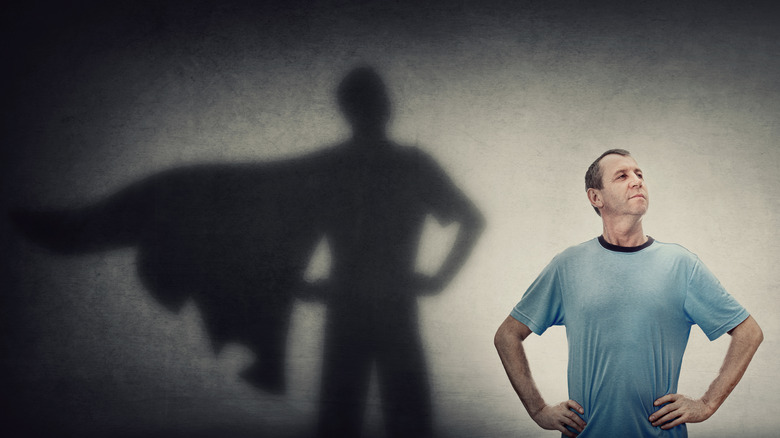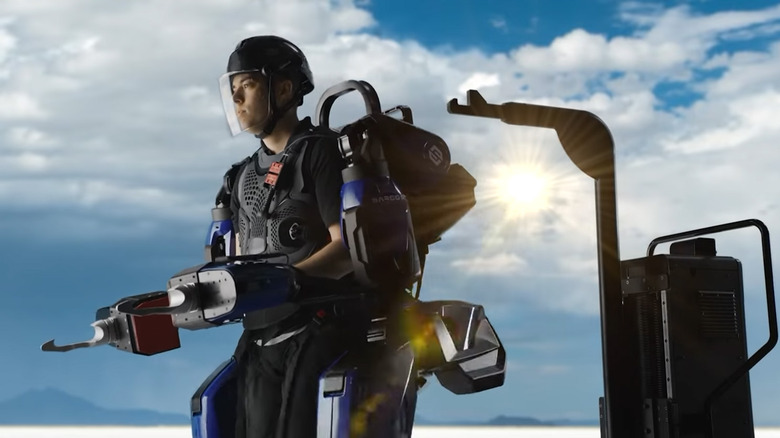Gadgets That Turn You Into A Superhero You Can Buy Right Now
So you've decided that the superhero's life — that glamorous concoction of constant betrayal, underappreciation, depression, and occasionally substance abuse — is the life for you. Here are some products to get you started down the path to fighting crime with crime.
We've been a little picky about what's included. Almost everything is available for purchase somewhere, at some cost. We've prioritized actual function over cosplay accuracy and eschewed devices that look cool but probably couldn't be helpful except in the most extreme and narrow circumstances. (Hydroflight suits are a good example; it isn't easy to imagine performing any meaningful superhero activities tethered to them.)
All of this nitpicking inevitably leads away from superpowers and toward James Bond-esque gadgetry, but if Batman is a superhero, why isn't James Bond? If that question doesn't start enough of a fight, ask yourself this: Are Jedi (outside of games and AR) superheroes? They're undoubtedly supernatural, if that means anything, and more capable of heroism than half of the MCU. Besides, isn't Mjolnir effectively a gadget? If it doesn't count because we don't understand it, that also rules out cell phones and smart toasters as gadgets for most of us. In any event, useful gadgetry is the closest most of us will get to superherodom, so gadgetry it is.
Pyro Mini Fireshooter
There's not anything practical about the Pyro Mini Fireshooter (or its larger namesake, the Pyro, which doesn't seem to be available for purchase), but if anything will distract an opponent long enough to regroup or escape, it's throwing a ball of fire with your bare hands.
The original Pyro became something of a viral sensation in 2014. Since then, Pyro's maker, Ellusionist, has increased the fireball's size while cutting the wrist-mounted device's size in half. The Pyro Mini can be recharged via USB, triggered by a remote that functions up to 30 feet away, and fire two shots before reloading.
The magic behind the device is flash paper, a product made from nitrocellulose, which is most well-known as a finish for guitars and as guncotton, a replacement for gunpowder. The device also ships with some flash cotton, a more volatile form of nitrocellulose. The stuff burns easily, quickly, and dramatically and has been a staple of illusionists for ages to add drama and misdirection to an act as needed. Who can put drama and misdirection to use better than a superhero looking for an upper hand?
Dragon's Breath
Dragon's Breath is another fireball-creating substance from the world of stage magic, made up of spores from a clubmoss called lycopodium. Like other fine powders with a propensity for exploding (including flour and sawdust), lycopodium creates quite a show. It can generate more voluminous fireballs than the Pyro Mini, but you'll need a flame to ignite it, while the Pyro lights flash paper with a simple spark.
When lycopodium isn't blowing up in your face, it's causing jaundice and hepatitis when administered as a common herbal remedy. It also acts as a fingerprint-lifting powder and a lubricant for latex gloves and condoms.
For the aspiring superhero, though, lycopodium's value lies in its propensity to explode when airborne and exposed to sufficient heat. The stuff is gone in a flash, so you're unlikely to deal any real damage to a charging supervillain, but charging isn't usually their style. Better to use Dragon's Breath to distract while you reach down to pull the literal or metaphorical rug out from under them.
Nanotech bulletproof suit
Superheroes' uniforms often provide insight into the hero's character (and taste), and it matters. Frank Miller had Batman shot to get rid of the old yellow oval and fully seat his outfit in the pulp/noir persona of the Dark Knight (whose suit was, of course, full of gadgets). Iron Man was Tony Stark in a costume (and a fantastic one at that). It spoke effortlessly of steel and tech and maybe a touch of Ace Frehley.
Of course, suitable outfits are not just for the heroes. Catwoman's uniform evolved into a tight leather body suit, accessorized with a whip and a big ring as a front zipper pull. It was a costume in need of a safe word. But what if your persona needs to say "strategic planning" and "profit maximization" while at the same time repelling projectiles?
Garrison Bespoke's nanotech bulletproof suits are functional and stylish. It's not altogether difficult to imagine a superhero or his alter ego: corporate raider by day, C-suite bad boy by night. The suits use carbon nanotubes, a long-hyped technology finally finding its way into real-world applications, including bullet-stopping. The fabric is thin, flexible, and half the weight of Kevlar. Couple that with a notch lapel, narrow sleeves to emphasize muscle, and a hand-rolled cap to broaden the shoulders. You'll look competent, experienced, and more than a little dangerous — no word on whether Garrison's suits are intended for superheroes or supervillains.
D3O impact-proof body armor
If you expect frequent brawls or defenestrations and don't mind a more mech-y look, check out D30's impact-proof body armor options. D30 supplies the defense industry and the bike sports world with armor that has to be highly effective against blunt force. The company's demo video is both alarming and convincing. How could you prepare for Syndrome, or even Incrediboy, without "the world's best impact protection"?
D3O's defense industry arm calls its materials "Delta Three Oscar," a variety of technologies in the form of sheet goods that are then translated into body armor. Knowing that even the most muscular superheroes occasionally take a beating, why not prepare for it upfront with a suit with the right combination of materials for your mission?
Rugged mil-spec uniforms are nothing new, of course. But some recent advances, such as the blast-proof material made by Russian state-owned manufacturer Rostec, are pretty convincing. Unfortunately, it might be a while before you can buy anything from Rostec.
Gravity jet suit
Speaking of Incrediboy, his jet boots might not be ready for retail, but flying seems worthwhile for a superhero. Jet packs have been around for a while and can at least keep you from resorting to an eFoil or Uber when you need to get across the river to confront your nemesis. Gravity's jet suits trade the Incrediboy boots for arm-mounted thrusters and the standard sci-fi backpack.
Gravity's branding already has a superhero feel, with the logo designed for a spacecraft's bow and the black leather suits. Gravity founder Richard Browning may very well have a cape in his closet.
You'll only get 5-10 minutes of flight time and 55 mph out of this thing's 1050 horsepower, but do you want to go any faster than that if you get into an accident? These jet suits are a surprising combination of terrifying and dull to watch. Because all the action happens above the waist, one's legs tend to dangle, which isn't the most superheroic of physical postures. One suggestion — learn to Riverdance. You don't need fireballs to distract foes when jetting around with your legs dancing a jig. You might as well wear your bulletproof suit because if you can afford $450,000 for a Gravity jet suit, you can afford that, too.
Wingsuit flying
If awkward jetpacks and Black Rebel Motorcycle Club outfits aren't part of your superbrand, perhaps you should consider a wingsuit. It's closer to the natural state of non-bat mammalian flight (i.e., a controlled fall) and looks more impressive. It might not serve you well in sea-level escape scenarios, but you'll get some great PR shots, assuming you survive. (The inventor of one wingsuit forerunner didn't.)
Wingsuit skydiving works like this: you jump out of an airplane at about 12,000 feet and travel approximately 4.5 miles while gliding about 3,000 feet. Ideally, you'll encounter and defeat the day's villains by then because, at 9,000 feet, you should deploy your parachute and start wondering why there are no retirement-age adrenaline junkies. You can rent a wingsuit, but that will severely limit your ability to add a logo, so why not go all-in and spend the $2,000 for a custom suit? Besides, after factoring in all the training, licensing, equipment, and (one imagines) insurance, the ability to fly could cost you upward of $30,000.
Another piece of advice: give yourself an excellent bird-related supername before the newspapers call you the Flying Squirrel. You might also want to steer clear of phoenix- and albatross-derived names.
Hacksmith Mini-Saber
It will do you no good to get into a duel with a villain at 10,000 feet unless you have the super strength or weaponry to win the fight. After all, if anyone is equipped to manage a battle without weapons, it's the Jedi. Whether or not you can reasonably call a Jedi a superhero, there can't be a downside to wielding a real lightsaber capable of cutting through a metal door (eventually).
The Hacksmith Mini-Saber is based on a prototype made by YouTuber James Hobson. Hobson's original saber was full-size and intimidating in every sense, particularly in the $40,000 sense of what Hobson spent making it. It burned propane at 4000 degrees and would cut through a steel door given enough time (and probably through your arm much faster). Indeed, it was beyond full size because it required an enormous backpack loaded with a steampunk array of tanks, gauges, and copper tubes. When it came time to produce a product within reach of consumers and the limits of liability insurance, Hobson built the Hacksmith Mini-Saber, a butane-powered torch with a 4-6-inch flame.
Today's production model functions more like a grill lighter than a weapon. You certainly don't want to whip it out when overmatched, lest you look like Malcolm Reynolds bringing a dagger to a swordfight in Serenity. But there are other ways to use weapons, and while we won't suggest any, you can probably imagine a few. And, anyway, even super-grills need to be lit.
Robo strength suits and exoskeletons
Weapons are fine, but the superhero tradition favors superior strength over firepower. Those who didn't win the genetic lottery or work out 16 hours daily can use a bionic or robotic option to deal with maniacs and minions. Robotic suits and exoskeletons that give you superhuman strength have been around for decades, and there are almost always one or two manufacturers in business at any time. Currently, Sarcos and Cyberdyne are bringing you ways to shift freight ergonomically while practicing your vigilantism.
The use cases for Sarcos' Guardian XO include military, defense, aviation, and aerospace scenarios, far more superhero-like than the typical example of shifting things about in a warehouse. Its looks are somewhere between Optimus Prime and BioShock's Big Daddy, but without the steampunk. Sarcos claims the suit will multiply your strength up to 20 times but caps that at 200 lbs. While a superhero who can only lift 10 lbs. might be in the wrong business, it's also true that holding 50 lbs. at the end of fully extended arms isn't something to scoff at.
Cyberdyne's HAL is more akin to bionics and focused on overcoming difficulties in walking, a superheroic act itself. Cyberdyne's "lower limb type" (read: leg) devices are helpful to those with disabilities and give run-of-the-mill minions pause as a bonus.
Grappling guns
A lot of superhero tech seems to be about getting places that are usually inconvenient, such as a balcony where a hostage is held against their will or a high Lowe's shelf where a cordless tool is held against your will. That's where a good grappling gun comes in — and possibly a sturdy rolling carrying case because these things aren't small.
You might feel silly carrying around tons of equipment that makes you look like you've bought tactical exterminator gear, but always remember — function over form, except when the opposite is true. In this case, you'll benefit from the ability to scale Rouen Cathedral by launching a grappling hook to the top with what suddenly looks more like a backpack missile launcher than an anti-termite weapon. Atlas Devices, who serve everyone from special forces to telecom and utility linesmen, has an extensive range of products to get you up where the bad guys don't expect you to be.
Pro tip: don't scale Rouen Cathedral. You will go to jail, superhero or not.
Personal submarine
A certain demographic may have dreamed of owning a personal submarine since seeing one come after James Bond in "The Spy Who Loved Me." Well, now you can have one. If your alter ego is more about stopping supervillains (at least, the more wet villains) than being a dangerously unsupervised nerdy child, it shouldn't be hard to turn your sub into a super-asset. The best (or maybe worst) part is that your SuperSub is available today for a mere $300,000. The downside is that it won't be that impressive to anyone who happens to have seen the sub when flipping through SkyMall.
You'd only need to paint it some color other than bright yellow and fit a few accessories to the hull. Think harpoon launcher or torpedo tube. However, we must discuss a vital downside: this isn't a submarine but a "partially submersible watercraft." You can sit fully under the water's surface, but most of the vessel will float above the waterline (the best place to float).
The floaty part looks like a child's pool toy, so we suggest maximizing the potential stealth by making it look like just that and perhaps painting it to resemble a (surprisingly fast-moving) rock or a gigantic turtle with handles. After all, you only have to get close enough to find the lair's entrance, and all the action will likely occur outside your partially submersible watercraft.
DIY bonus: Colin Furze's Magneto shoes
OK, so you can't buy this one, but we had to have one DIY project in the mix, and who better to guide you through a good, ill-advised DIY project than YouTuber, "mental machine" maker, and punk rock aficionado Colin Furze? The trouble with Furze will be selecting a project to recreate from his tons of terrible ideas. A secret tunnel that took three years? Hoverbike? Weaponized screwtank watercraft? 100 horsepower bumper car? Furze has made more death traps than practical inventions. He gets away with it because the complexity and insanity of his builds make imitators unlikely.
Not so his Magneto upside-down shoes, which are comparatively simple, if no less dangerous than his other ideas. There's nothing more super or ill-advised than attempting to walk upside-down. Inevitable soft-tissue injuries aside, Furze's Magneto shoes are relatively safe, though walking doesn't seem practical.
Furze's video speaks for itself: balance while stepping is impossible, and hydration is a no-go. So keep the upside-down excursions short in terms of both time and distance. The superhero value here is among the most potent weapons: unexpectedness. Where your presence is unexpected, you will not be discovered until you strike — your enemy on the head with the keys falling out of your pocket, that is.



